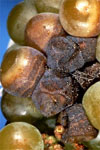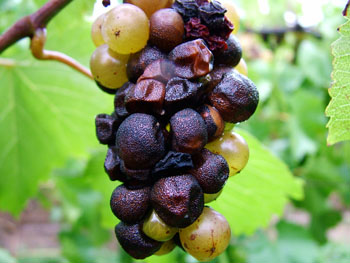Symptoms Management Causes More info
Damon Smith, Oklahoma State University
Symptoms
Symptoms on infected leaves appear as tiny, sunken, reddish-brown flecks with yellow halos. Spores (conidia) also can infect shoots, petioles, and pedicels. When pedicels are infected the fungus may become inactive until fruit mature. Fruit become susceptible to infection after veraison. Once fruit are infected, they soften and small fungal fruiting structures (acervuli) form in concentric rings on the surface. When light-colored fruit are infected, they turn brown. Infected dark-colored fruit take on a roughened, sparkly appearance and fruit often collapse. Spores from the acervuli present on fruit can be rain-splashed to other fruit and cause subsequent infections. Bitter rot is often confused with black rot; however, the fungus that causes black rot infects immature fruit, while the fungus that causes bitter rot infects mature fruit.
Cultural Management Options
- Sanitation is extremely important, since the primary source of spores for new infections results from structures formed in old plant tissue.
- Proper dormant pruning and destruction of old canes, clusters, and other plant parts can significantly reduce the number of spores.
- Remove mummies (raisin-like, hard remnants of fruit) from the canopy.
- Cultivate or bury the debris to help limit damage caused by the bitter rot fungus.
- Canopy management during the season can help to increase airflow, which reduces leaf wetness duration (a primary component for infection).
- Practices such as shoot positioning and strategic leaf pruning can reduce drying time.
Chemical Management Options
Protection of fruit with fungicides is important from bloom to harvest, especially for susceptible cultivars during warm, wet weather. A complete fungicide program targeting black rot will help manage the disease. However, once black rot fungicide applications have ceased, after veraison, fungicides directed toward bitter rot management should be continued until the pre-harvest period. However, if fungicide use is contemplated, remember to check on the pre-harvest interval (PHI) of that fungicide to be sure it can be used close to harvest. Consult with a county Extension office for current fungicide recommendations for bitter rot management.
Causes
Bitter rot is caused by the fungus Greeneria uvicola. The fungus overwinters in plant debris, canes, and old mummified fruit. During rain events, spores of the fungus are carried from structures called acervuli imbedded in plant tissue. The spores can infect all green portions of the plant.
Recommended Resources
 Bitter Rot of Grape, Ohio State University
Bitter Rot of Grape, Ohio State University
Midwest Small Fruit and Grape Spray Guide
Field Guide for Integrated Pest Management in Pacific Northwest Vineyards, Washington State University
Reviewed by Bruce Bordelon, Purdue University and Eric Stafne, Mississippi State University

